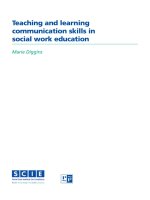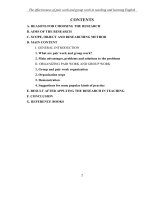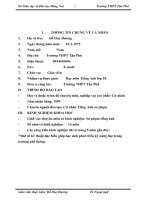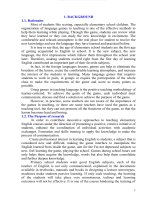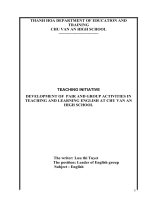skkn does group work help enhance or give more interest in teaching and learning reading comprehension
Bạn đang xem bản rút gọn của tài liệu. Xem và tải ngay bản đầy đủ của tài liệu tại đây (152.84 KB, 15 trang )
Teaching and Learning Reading comprehension
Giáo viên: Trương
Mỹ Linh
Does group work help enhance or give
more interest in teaching and learning
reading comprehension?
BACKGROUND TO THE TEACHING OF READING
Reading comprehension is part of foreign language teaching. Reading
comprehension skills increase the pleasure and effectiveness of reading. Strong
reading comprehension skills help in all the other subjects and in personal and
professional lives. The high stakes tests that control advancement through
elementary, middle and high school and which determine entrance to college are
in large part, a measure of reading comprehension skills. While there are test
preparation courses which will provide a few short-cuts to improve test-taking
strategies, these standardized tests tend to be very effective in measuring a
reader’s reading comprehension skills. In short, building reading comprehension
skills requires a long term strategy in which all the reading skills areas (phonics,
fluency, and vocabulary) will contribute to success.
Reading is a fluent process of readers combining information from a text
and their own background knowledge to build meaning. The goal of reading is
comprehension. Reading is an essential skill for learners of English. For most of
these learners it is the most important skill to master in order to ensure success
not only in learning English, but also in learning in any content class where
reading in English is required. With strengthened reading skills, learners will
make greater progress and development in all other areas of learning.
According to Donald Martin (1991), reading comprehension requires
motivation, mental frameworks for holding ideas, concentration and good
techniques. Motivation and interest are created by previewing material, asking
1
Teaching and Learning Reading comprehension
Giáo viên: Trương
Mỹ Linh
questions, and discussing ideas with classmates. The stronger the learner’s
interest is, the greater his or her comprehension becomes.
THE TEACHING OF READING SKILLS AT HIGH SCHOOLS
English is one of the compulsory subjects at high schools, and it has
become more popular and helpful. More and more students show their interest
in learning English, especially in speaking and writing. They often find it hard
and uncomfortable to learn reading. Students feel uncomfortable and study
reading comprehension ineffectively because of some reasons. This is a
problem for teachers.
To students at high schools, reading in English is what they have to do at
schools. They have to deal with a large number of unknown words and
complicated grammatical rules for coming examination. Reading is boring
chores to do.
At high schools, the textbook for each level is designed to include 16
reading passages, grammatical points, listening and speaking tasks. Students
have to cover them all in a year.
As a rule, teachers have to stick to the textbook, the only teaching materials that
are at their disposal. Within a bottom-up approach to reading, the most typical
classroom focus is on what we call intensive reading. Most of the reading
passages in the textbooks are short and followed by textbook activities to
develop comprehension or a particular reading skill. Most textbooks used to
teach foreign language reading use an intensive reading approach. The students
have no time for extensive reading (ER). From my teaching point of view,
students should be encouraged to read more from other sources besides the
textbook. Data collected from pre-experiment questionnaire showed that most
of the students dislike English reading comprehension because of their poor
vocabulary and the lack of suitable materials.
2
Teaching and Learning Reading comprehension
Giáo viên: Trương
Mỹ Linh
THE ROLE OF EXTENSIVE READING IN LANGUAGE LEARNING
Although extensive reading can be contrasted with intensive reading, I tend to
switch my students (students majoring in English) to extensive reading due to
the role of extensive reading in language learning.
•
It can provide 'comprehensible input'. In his 1982 book, Krashen argues
that extensive reading will lead to language acquisition, provided that
certain preconditions are met. These include adequate exposure to the
language, interesting material, and a relaxed, tension-free learning
•
environment
It can enhance learners' general language competence. Grabe (1991:391)
and Paran (1996:30) have emphasized the importance of extensive
reading in providing learners with practice in automaticity of word
recognition and decoding the symbols on the printed page (often called
•
bottom-up processing).
It can increase knowledge of vocabulary. Nagy & Herman (1987)
claimed that children between grades three and twelve (US grade levels)
learn up to 3000 words a year. It is thought that only a small percentage
of such learning is due to direct vocabulary instruction, the remainder
being due to acquisition of words from reading. This suggests that
traditional approaches to the teaching of vocabulary, in which the
number of new words taught in each class was carefully controlled
(words often being presented in related sets), is much less effective in
promoting vocabulary growth than simply getting students to spend time
•
on silent reading of interesting books.
It can motivate learners to read. Reading material selected for extensive
reading programs should address students' needs, tastes and interests, so
as to energize and motivate them to read the books. In the Yemen, this
was achieved through the use of familiar material and popular titles
reflecting the local culture (e.g.. Aladdin and His Lamp). Bell &
3
Teaching and Learning Reading comprehension
Giáo viên: Trương
Mỹ Linh
Campbell (1996, 1997) explore the issue in a South East Asian context,
presenting various ways to motivate learners to read and explaining the
role of extensive reading and regular use of libraries in advancing the
•
reading habit .
It helps to build confidence with extended texts. Much classroom reading
work has traditionally focused on the exploitation of shorts texts, either
for presenting lexical and grammatical points or for providing students
with limited practice in various reading skills and strategies. However, a
large number of students in the EFL/ESL world require reading for
academic purposes, and therefore need training in study skills and
strategies for reading longer texts and books. Kembo (1993) points to the
value of extensive reading in developing students confidence and ability
•
in facing these longer texts.
It encourages the exploitation of textual redundancy. Insights from
cognitive psychology have informed our understanding of the way the
brain functions in reading. It is now generally understood that slow,
word-by-word reading, which is common in classrooms, impedes
comprehension by transferring an excess of visual signals to the brain.
This leads to overload because only a fraction of these signals need to be
processed for the reader to successfully interpret the message. Kalb
(1986) refers to redundancy as an important means of processing, and to
extensive reading as the means of recognizing and dealing with
•
redundant elements in texts.
It facilitates the development of prediction skills. One of the currently
accepted perspectives on the reading process is that it involves the
exploitation of background knowledge. Such knowledge is seen as
providing a platform for readers to predict the content of a text on the
basis of a pre-existing schema. When students read, these schema are
activated and help the reader to decode and interpret the message beyond
the printed words. These processes presuppose that readers predict,
4
Teaching and Learning Reading comprehension
Giáo viên: Trương
Mỹ Linh
sample, hypothesize and reorganize their understanding of the message
as it unfolds while reading (Nunan 1991: 65-66).
WAYS OF ACTIVATING STUDENTS’ INTEREST AND MOTIVATION
How to teach a reading comprehension lesson effectively has always
been a difficult task for teachers, how to draw students’ interest may be a more
important question. This will lead to the success of teachers’ teaching.
Effective teaching and learning in the classroom involves negotiating
among classroom factors. However, a factor essential to successful learning is
the motivation of students. That is why teachers need to pay attention to the
interests and needs of the students.
In fact, attitudes of students are an important consideration. It is
necessary for teachers to know the students’ attitude towards the lesson and the
teaching approach. From my teaching experience, a student who is eager to
learn English will do better than those who are force to study or have to study in
an environment which is not suitable for them.
As a teacher of over 20 years of teaching English, I have struggled to know how
to implement reading theory in the reading classroom. Knowing how to
integrate the theory of reading into appropriate classroom practice has been my
challenge. I often organize a teaching system for reading based on some key
elements of reading such as activating prior knowledge, cultivating vocabulary,
teaching for comprehension …
How to get students more involved in their own learning process? Some
classroom techniques and tasks have been chosen in terms of pre-task, task, and
follow-up. Pre-tasks have been made use of in order to create interest, help
build students’ schema in relation to the topic, introduce key vocabulary …
5
Teaching and Learning Reading comprehension
Giáo viên: Trương
Mỹ Linh
A number of tasks can be used to activate language in the classroom. Some of
the more popular task types in the communicative classroom include: roleplays,
simulations,
problem-solving,
discussions,
decision-making
and
information gaps. Information gap tasks in which two or more students have
access to different information that they have to share in order to complete the
task are popular because students can work well with one another at most levels
of proficiency from post-beginner to advanced; all students have to take part
and participate actively and they work well with mixed level groups.
Group work is one pedagogical strategy that promotes participation and
interaction. It fosters a deeper and more active learning process, and it also
provides teachers with valuable demonstrations of the degree to which students
understand particular topics or concepts. It allows students to work together in
small teams, combining students with varying backgrounds, experience,
technical and intellectual competencies towards the attainment of a specific
objective. Working in groups, students are stimulated to think ‘outside the box’,
thus acquiring increased levels of perception, awareness, reasoning and
judgment abilities.
Research has shown that groups frequently devise more and better solutions
than the most advanced individual (Barkley et al., 2004; Cooper et al., 2003).
Working together in groups also gives students the opportunity to learn from
and teach each other. Classroom research has shown that students often learn
better from each other than they do from a teacher (Barkley et al. 2005, 16–20).
The students of a group can make more progress. As groups are often formed
with students of varying abilities, excellent ones can help their less intelligent
peers to keep up with the learning. Brilliant students can also benefit from group
work as their understanding of lessons is reinforced. Most of the arising
misconceptions are quickly dealt with and eliminated through discussions,
precluding them being incorporated into the conceptual framework. In addition,
6
Teaching and Learning Reading comprehension
Giáo viên: Trương
Mỹ Linh
slow students can gain more confidence and motivation when working with
intelligent ones.
Furthermore, various social skills can be learned and honed during group work.
Self-expression, decision-making, responsibility, conflict management, time
management, listening, task allocation, sharing, emotion control and so on are
practiced naturally and frequently when students working in a group. The skills
gained in group work reduce the occurrence of academic and occupational
trouble later in life.
IMPLEMENTATION PROCESS
The implementation was monitored at Luong The Vinh High school for the
Gifted. This technique was applied to some of the reading passages in the text
book for Grade 10 (Unit 3, Unit 6, Unit 7, Unit 11 and Unit 12).
The students in the innovation are Grade 10 students who major in English.
According to the curriculum for high school students, each class has 3 periods
per week for English. On average, the teacher has 6 periods to cover the whole
lesson. Each lesson includes such parts as reading, speaking, listening, writing
and language focus. To achieve the implementation, the teacher had to be wellprepared for the plan. The tasks as well as the guidelines had to be assigned to
the students so that they could work effectively at home and get their
assignment beforehand.
It is necessary for the teacher to design suitable tasks or activities and groups for
the students. The types of tasks and groups designed are based on the features of
the reading passages.
The implementation can be carried out before or after the teaching of the
reading passages in the text book.
Prior to each reading passage, it is beneficial to engage students in an activity
that gets them thinking about what they already know about the topic of
reading. The reading passages in the text book are sometimes too short to
provide students with necessary information. Unit 11 is used as an example for
7
Teaching and Learning Reading comprehension
Giáo viên: Trương
Mỹ Linh
this. In this case, the class should be divided into 3 groups randomly. Each
group will be in charge of one national park mentioned in Unit 11. The students
will work in groups outside the class with detailed guidelines from the teacher.
Most of the tasks are often done at home because the time limited for each
lesson at school is fixed. Students have to search for the information from
various sources such as books, magazines, other materials or some websites on
the Internet … This is a good chance for students to develop Extensive reading.
They have to read many books or longer segments of text but they are free to
choose the books, or the materials that can match their interest, ability and
needs, which help foster students’ developing reading habits and interests.
Then, all of the members of a group will work together to select the suitable
information for the topic (location, some special features …) and prepare for the
short presentation in class.
•
How to Form Groups
Small groups or learning teams can be formed in four ways: randomly, teacherselected, by seat proximity, or student-selected. Random and teacher-selected
group assignments avoid cliques and ensure that students interact with different
classmates throughout the semester.
The teacher also wants to consider using the students’ hobbies toward the topic
as a mechanism to help create groups. Take a one-question survey before
grouping the students.
Suggested questions:
Unit 7:
Which of the following TV programs do you like to watch best?
a. cartoons
b. game shows
c. films
d. music
e. newsreel
d. classic
e. jazz
Unit 12: What sort of music do you often listen to?
a. folk / country
b. pop
c. rock
8
Teaching and Learning Reading comprehension
Giáo viên: Trương
Mỹ Linh
Those who choose (a) can be put into a group of their own. They can find it
interesting to work together because they have the same taste. Once they are
really satisfied by group work, they will be eager to work.
Group Size and Duration
Group size and the length of time that students work together can vary. It might
•
be four, five or six people. If there are more people in a group, some members
will stop participating. In large groups it is useful to assign roles within each
group (examples: recorder, reporter to the class, timekeeper, monitor, or
facilitator).
If students are not used to working in groups, giving some guidelines with the
class about respectful interaction before the first activity can foster positive and
constructive communication.
It is useful to arrange the students in groups before giving them instructions for
the group activity, since the physical movement in group formation tends to be
distracting.
•
The Structure of Group Work
Successful group work activities require a highly structured task. The teacher
should make this task clear to students by writing specific instructions on the
board or on a worksheet.
The instructions must be included:
- The learning objectives
- The specific task:
Choose the TV channel you like. State the reasons for your choice.
List all the programs included in the channel.
Recommend some interesting programs to your friends.
- The expected product: for example, reporting back to the class; handing in a
9
Teaching and Learning Reading comprehension
Giáo viên: Trương
Mỹ Linh
sheet of paper.
- A time limit: depending on the topic or the questions (for example, 4 days or
one week)
•
Fostering Group Interaction
During group work, the teacher should circulate and listen to the students to
check if they are on task or they are talking about something else. If the students
have to work on the assignment at home, the teacher will try to keep in touch
with the students by email to make sure that they understand the assignment.
When the students have questions during their group work, it is important not to
answer questions – at least not at first. Instead, the teacher will ask the other
group members how they would approach the question. If no one in the group
has an idea, the teacher can give the group either a start on how to answer it or a
clue to the questions.
On implementing group work for the first time in their section, the teacher will
find that the students fall awkwardly silent when the teacher walks by or listens
to their discussion. This is only temporary, and it should stop once the students
are familiar with the teacher and the group-work format. Because unfamiliarity
drives this reaction, it is good to implement group work very early in the
semester and to use it often.
IMPROVEMENTS
There is a saying “More hands make light work”. Researchers report that,
regardless of the subject matter, students working in groups tend to learn more
of what is taught and retain it longer than when the same content is presented in
other instructional formats.
10
Teaching and Learning Reading comprehension
Giáo viên: Trương
Mỹ Linh
Teachers should make good use of group work to help students learn from each
other, build community, and teach cooperation.
More people on a project or a topic lead to more points of view and ideas. In a
group, students can bounce ideas off one another or generate new ideas, which
in turn leads to creative ways to approach or solve a problem. More partners,
more knowledge and opinions will help students fully understand the lessons.
Working in groups reduces the overall workload since each student has a
portion of the assignment to complete. This is even more beneficial if the
assignment or the project requires different parts such as writing, designing a
display or presenting the information. Each student can complete the task he /
she is best suited for, which fosters the best expected product since each
individual focuses on his strengths.
Group work is seen as motivational because students recognize that their
success or failure in the attainment of the specified goal is dependent on them
being able to work together as a team. They thereby encourage each other to get
the assigned tasks done properly and on time.
CONCLUSION and RECOMMENDATIONS
Group work, the classroom technique, exposed the students to more varied
language input and output. The teacher attempted to provide the students
with opportunities to listen, speak, write, read, see, and interact to learn
English.
We view learning as a process in which students construct their own
knowledge and are responsible for their own learning. The activity,
inquiry-oriented, should develop students’ thinking skills and foster
cooperative learning and, consequently, the role of the teacher will have to
11
Teaching and Learning Reading comprehension
Giáo viên: Trương
Mỹ Linh
change from presenter of information or classroom authority to coach or
facilitator to assist, direct, and guide the student (Miller, 2000)
Regular dependent reading time must be provided for the student to
practice the strategies (Pardo, 2004). Pardo also stated that reading
becomes better with practice and comprehending becomes better with more
reading practice.
According to Pardo, motivation to read can impact a reader’s persistence in
reading. Students with higher amount of motivation are more likely to
apply the use of comprehension strategies while reading. Although there
are many motivational factors that are not within the teachers’ control,
teachers are able to motivate students to read by providing interesting text,
allowing choices to be made as levels of engagement increase, so does
comprehension (Grimes, 2003).
The implementation of this novel method, if successful, will be a major
pedagogical breakthrough due to its enormous potential. Indisputably, groupwork produces an animated and enticing atmosphere conducive to acquisition of
knowledge. To clarify, whereas an average reader can spend approximately one
hour reading “genuinely” before saturation occurs, for group-work members,
the amount of time devoted to actual reading is augmented. In addition,
additional language skills can be integrated, specifically listening and speaking.
There can be discussions relevant to the reading materials afterwards to
consolidate contents’ comprehension and possible extension of the debated
subject. It is worthwhile and entertaining; also it retains their attention and
enthusiasm. Furthermore, this method is particularly ideal for pre-intermediate
and intermediate students due to their inquisitive and interaction-demanding
nature; advanced learners are not recommended on the grounds that they are
generally capable of performing independently.
12
Teaching and Learning Reading comprehension
Giáo viên: Trương
Mỹ Linh
The selection of materials is indispensable for the successful execution of this
method. Therefore, it is advisable that the contents be comparatively
straightforward, not super-perplexing or vocabulary-loaded; topics should be
interesting and stimulate individual participation and contribution. Besides, a
competent leader should be appointed to control and navigate the group and
group members favorably should consist of close friends or those having at least
something in common in order to maintain a harmonious atmosphere and to
avoid imminent conflicts.
13
Teaching and Learning Reading comprehension
Giáo viên: Trương
Mỹ Linh
REFERENCES
-
Barkley, E., et al. (2005). Collaborative Learning Techniques. San
Francisco: Jossey-Bass.
-
Bell, T., & Campbell, J. (1996). 'Promoting Good Reading Habits: The
Debate.' Network 2/3 (pp 22-30).
-
Bell, T., & Campbell, J. (1997). 'Promoting Good Reading Habits Part 2:
The Role of Libraries.' Network 2/4 (pp 26-35).
-
Grabe, W. (1991). 'Current developments in second language reading
research.' TESOL Quarterly 25/3: 375-406.
-
Grimes, Sharon. “The Search for Meaning. How you can Boost Kids’s
Reading Comprehension” in School Library Journal. May 2004. p48-52
-
Kalb, G. (1986). 'Teaching of extensive reading in English instruction at
the senior gymnasium level.' Die Neueren Sprachen, 85, (pp 420-430).
-
Kembo, J. (1993). 'Reading:Encouraging and Maintaining Individual
Extensive Reading.' English Teaching Forum, 31/2, (pp 36-38).
-
Krashen, S. D. (1982). 'Principles and Practice in Second Language
Acquisition.' New York: Prentice Hall.
-
Miller, L. (2000)” Using information technology to foster cultural
knowledge and awareness: An interview with award-winning teacher
Cheryl Cox.” Reading online, 4, 5.
-
Nagy, W., & Herman, P. (1987). 'Breadth and depth of vocabulary
knowledge: Implications for acquisition and instruction.' In Mckeown,
14
Teaching and Learning Reading comprehension
Giáo viên: Trương
Mỹ Linh
M., & Curtis, M. (eds), The nature of vocabulary acquisition. Hillsdale,
NJ: Lawrence Erlbaum. (pp 19-35).
-
Nunan, D. (1991). 'Language Teaching Methodology: A Textbook For
Teachers.' London: Prentice Hall.
-
Paran, A. (1996). 'Reading in EFL: facts and fictions.' English Language
Teaching Journal, 50/1, (pp 25-34).
-
Pardo, Laura S. “What Every Teacher Needs to Know About
Comprehension” in The Reading Teacher. Nov. 2004 p. 272-281
Người thực hiện
Trương Mỹ Linh
15
